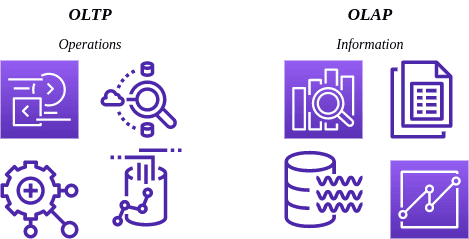1. Introduction
OLTP and OLAP are essential processing systems in modern data management and analysis. OLTP focuses on real-time data updates, while OLAP excels in complex data analysis and reporting.
In this tutorial, we’ll explore their architectures, data models, and processing operations. We’ll also walk through their performance characteristics, along with their practical applications and use cases.
2. OLTP
To grasp the essence of OLTP systems, it is crucial to understand their architecture and infrastructure. OLTP systems are designed to handle high transaction volumes and ensure data integrity in real-time. They typically employ a client-server architecture, where multiple clients interact with a centralized database server.
The infrastructure of an OLTP system focuses on high availability, ensuring that the system remains operational even during peak usage periods. Dedicated hardware, failover mechanisms, and backup systems are commonly implemented to achieve this.
Additionally, OLTP systems prioritize quick response times to support the fast-paced nature of transactional processing. The infrastructure is optimized for efficient data insertion, modification, and deletion, allowing businesses to process and record transactions in a timely manner while maintaining the integrity of the data.
3. OLAP
In contrast to OLTP systems, the architecture, and infrastructure of Online Analytical Processing (OLAP) systems are tailored to meet the demands of complex data analysis and reporting. OLAP systems typically rely on a multi-tier architecture that includes data sources, data warehouses, and OLAP servers.
Data extraction, transformation, and loading (ETL) processes are crucial in OLAP systems to consolidate and organize data from various sources into a central data warehouse. The data warehouse serves as a repository for historical and aggregated data optimized for analytical queries.
OLAP servers employ multidimensional data models, such as star schema or snowflake schema, to facilitate efficient and fast data analysis. These systems often incorporate advanced techniques like indexing, pre-aggregation, and caching to enhance query performance. The architecture and infrastructure of OLAP systems prioritize scalability and flexibility to handle large data volumes and support complex analytical operations, empowering organizations to derive meaningful insights and make informed decisions based on comprehensive data analysis.
4. Main Differences
The main differences between OLTP and OLAP lie in the data model and the structure, which results in different performance and scalability:

4.1. Data Models
OLTP systems use a relational data model to organize data into tables with predefined relationships and constraints. Normalization is a fundamental principle in OLTP data modeling, aiming to eliminate redundancy and maintain data consistency.
The relational model ensures structured storage and enforces transactional integrity through primary key constraints, foreign key relationships, and database normalization rules. OLAP systems use multidimensional data models, such as the star and snowflake schemas, for efficient and flexible data analysis.
These models allow for efficient slicing, dicing, drill-down, and data aggregation across multiple dimensions. OLAP systems utilize hierarchies, levels, and measures to represent complex relationships and perform advanced analytical operations.
4.2. Data Storage and Processing Structures
OLTP systems prioritize efficient transactional processing and data storage with row-based storage structures and indexing techniques like B-tree indexes. They prioritize fast data insertion, modification, and deletion, ensuring transactional consistency and data integrity.
On the other hand, OLAP systems focus on analytical processing and efficient querying of large datasets with column-based or hybrid columnar storage structures. Advanced indexing techniques, such as bitmap indexes or compression, accelerate analytical query operations. Pre-aggregation and materialized views are commonly employed in OLAP systems to store pre-calculated results and optimize query response times.
4.3. Performance
OLAP systems prioritize complex analytical computations and reporting capabilities, often involving large volumes of data. They employ advanced techniques like indexing, query optimization, and pre-aggregation to improve query response times for complex queries. In-memory processing and columnar storage formats are commonly used to enhance performance.
4.4. Scalability
The performance of OLAP systems heavily depends on the design of multidimensional data models, ETL processes efficiency, and optimization of analytical queries. Scalability considerations in OLAP systems revolve around efficiently handling large volumes of data and accommodating growing analytical workloads. Vertical scaling, parallel processing, and distributed query execution techniques are employed to divide and conquer complex analytical queries, leveraging multiple computing resources. Data partitioning strategies, such as data sharding or partitioned views, can be applied to distribute data across multiple servers for improved scalability and performance.
5. Use Cases
OLTP and OLAP systems are essential in various industries and scenarios, catering to specific needs. OLTP systems are widely used in banking and finance for real-time transactions, while OLAP systems are crucial in e-commerce, reservation systems, supply chain management, and healthcare.
OLTP systems handle real-time reservations, bookings, inventory management, and order processing in e-commerce platforms. In contrast, OLAP systems are essential for business intelligence, data warehousing, sales and marketing analysis, financial analysis, and risk analysis.
OLAP systems help organizations analyze large volumes of data, identify potential risks, detect anomalies, and monitor key risk indicators, providing valuable insights for decision-making processes. Understanding these systems’ practical significance in the business world is essential for businesses to utilize these systems effectively.
6. Conclusion
In today’s digital era, organizations must differentiate between OLTP and OLAP systems to optimize data management and analysis capabilities. OLTP systems focus on real-time transaction processing, while OLAP systems specialize in complex data analysis.
The future of data management lies in integrating OLTP and OLAP systems, with Hybrid Transactional/Analytical Processing (HTAP) systems demonstrating the convergence of these domains. By leveraging their individual strengths and effectively integrating them, organizations can unlock data power, gain valuable insights, and make informed decisions to thrive in today’s data-driven landscape.